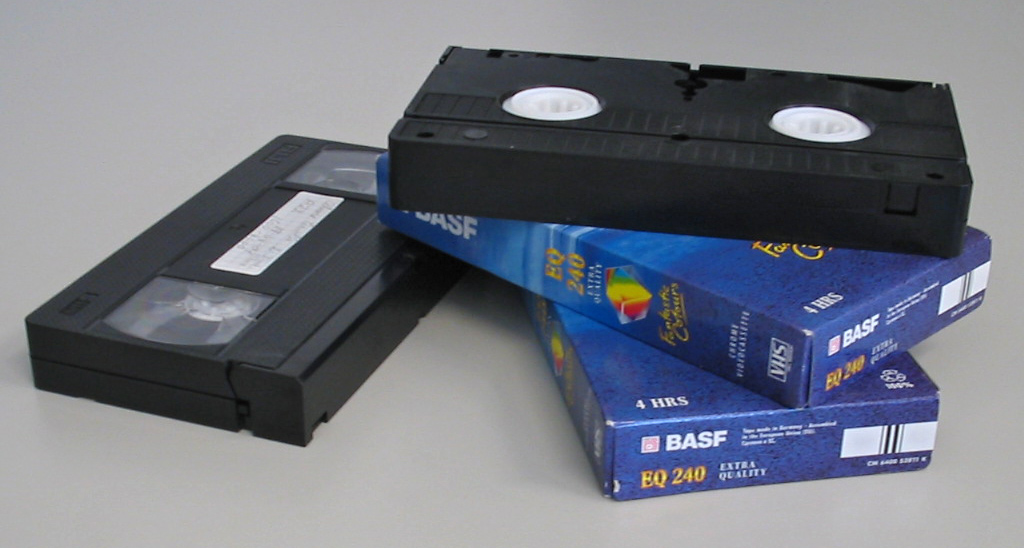VHS Tapes: An Analog Magnetic Tape Format for Video and Audio
Video Home System.
VHS tapes, also known as Video Home System tapes or simply tapes, are a type
of analog magnetic tape format that can store video and audio data. VHS tapes
were invented and developed in the late 1970s by the Victor Company of Japan
(JVC) and were the main competitor to the Sony Betamax system¹.
Types and Uses of VHS Tapes
VHS tapes come in different types and sizes, depending on the amount and type
of data they can store. Some of the common types of VHS tapes are:
- VHS: This is the standard type of VHS tape that is used for storing and playing movies and TV shows. VHS tapes can store up to 120 minutes of video and audio data on each side or 240 minutes in total. VHS tapes can also have stereo sound and hi-fi audio features, as well as closed captioning and multilingual subtitles.
- VHS-C: This is a smaller type of VHS tape that is used for storing and playing video recordings, such as home videos, camcorder footage, and surveillance videos. VHS-C tapes can store up to 30 minutes of video and audio data on each side or 60 minutes in total. VHS-C tapes are often used in portable devices, such as camcorders, video cameras, and VCRs.
- S-VHS: This is a type of VHS tape that can store higher quality video and audio data than standard VHS tapes. S-VHS stands for Super VHS and can store up to 120 minutes of video and audio data on each side or 240 minutes in total. S-VHS tapes can also have improved color resolution and reduced noise features, as well as digital stereo sound and hi-fi audio features.
- D-VHS: This is a type of VHS tape that can store digital video and audio data, such as high-definition (HD) content, digital satellite broadcasts, and digital cable programs. D-VHS stands for Digital VHS and can store up to 240 minutes of video and audio data on each side or 480 minutes in total. D-VHS tapes can also have Dolby Digital sound and DTS surround sound features, as well as copy protection and encryption features.
VHS tapes are widely used for various purposes, such as entertainment,
education, business, and personal use. VHS tapes offer many advantages over
other formats, such as:
- Affordability: VHS tapes are relatively cheap and easy to produce and distribute compared to other formats, such as DVDs or Blu-ray discs.
- Recordability: VHS tapes can be recorded over multiple times by users using VCRs or camcorders with recording functions.
- Compatibility: VHS tapes are compatible with most VCRs and devices with VCR drives, making them accessible and convenient.
- Availability: VHS tapes have a vast library of moving images that are unavailable anywhere else, such as rare or special editions of movies and TV shows, documentaries, educational programs, music videos, sports events, etc.²
History and Future of VHS Tapes
VHS tapes were developed by JVC as a way to create a new format that could
compete with the Sony Betamax system for video and audio storage¹. The first
prototype of a VHS tape was demonstrated in 1976 by JVC¹. The first commercial
VHS tapes were released in Japan in 1977 and in the United States in 1978¹.
The popularity of VHS tapes grew rapidly in the early 1980s, as more movies
and TV shows were released on VHS tapes and more consumers bought VCRs.
However, in the late 1990s and early 2000s, VHS tapes faced competition from
newer formats, such as DVDs, Blu-ray discs, MP3 players, and digital
downloads¹. DVDs offered higher quality and capacity than VHS tapes for video
storage, while Blu-ray discs offered higher quality and capacity than DVDs for
HD content. MP3 players and digital downloads offered more convenience and
flexibility than physical tapes.
Despite the challenges, VHS tapes still remain popular among some collectors
who prefer analog media over digital media or who want to own rare or special
editions of movies and TV shows on tapes². According to some estimates, there
were over 50 million VHS tapes sold worldwide in 2019².
The future of VHS tapes is uncertain, as the technology and consumer
preferences continue to evolve. However, VHS tapes are likely to remain
relevant for some time, as they offer a unique combination of affordability,
recordability, compatibility, and availability that is hard to match by other
formats.
Source:
(2) VHS Tapes for sale | eBay.
https://www.ebay.com/b/VHS-Tapes/309/bn_223820.
(3) Amazon.com: VHS Tapes.
https://www.amazon.com/VHS-Tapes/s?k=VHS+Tapes.
(4) VHS - Wikipedia.
https://en.wikipedia.org/wiki/VHS.
(5) VHS Tapes Are Worth Money - The New York Times.
https://www.nytimes.com/2021/02/20/style/vhs-tapes.html.
Do you have any feedback or suggestions? We would love to hear from you.
If you enjoyed this blog post, please share it with your friends and
leave a comment below.

Comments
Post a Comment
What's on your Mind?